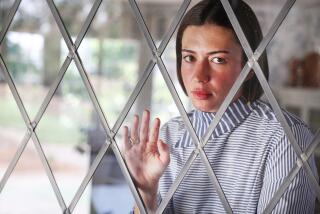Macaroni recipes and hand washing videos. How influencers are adapting to the coronavirus crisis
- Share via
Influencer and author Sasha Wilkins is seeing her biggest jump in viewership ever on her Instagram page, Twitter feed and lifestyle blog, where traffic has spiked 500% since the outbreak of the novel coronavirus. Wilkins has 46,000 followers on Instagram and nearly 100,000 on Twitter.
But those extra eyeballs are not being chased by ad dollars. The London-based blogger, who once worked for such brands as Microsoft, Samsung and Johnnie Walker, has seen her most lucrative deals suddenly dry up.
Just months ago, Wilkins, more widely known as her online alter-ego Liberty London Girl, was posting shots wearing flowy dresses while discovering Joshua Tree National Park as part of an all-expenses press trip with mall owner Simon Property Group. Instead of returning to L.A. to refuel her content in the coming weeks, she’s posting about household chores, gardening and cleaning up her dog’s poop.
“All my projects were canceled within the same week,” Wilkins said by phone from London. “My ongoing work has gone from busy to zero.”
For years, influencers have cashed in on an explosion in corporate advertising, as brands turned to online personalities and digital platforms to help create marketing buzz for their products. Advertisers spent $6.5 billion on influencers in 2019, up from $1.7 billion in 2016, according to global data from the Influencer Marketing Hub.
Additionally, platforms from Google’s YouTube to Facebook’s Instagram created pathways for a largely young but diverse crowd of writers, photographers, makeup artists and videographers to forge highly lucrative careers. Influencers earn money — some more than six figures — through ads, sponsorships and other projects.
But the coronavirus outbreak has upended that business model, especially in L.A., which has one of the largest concentrations of influencers in the country. Advertisers are dramatically curtailing spending in the face of record unemployment levels caused by stay-at-home orders that have shuttered businesses and live events. Digital ad spending is down 33%, according to the Interactive Advertising Bureau.
As a result, many influencers, who were already grappling with changing algorithms on platforms like YouTube and Facebook, are rapidly having to rethink how they engage with fans while they are sequestered in their homes.
“This whole industry has had to relook at itself during this time,” said Lauren Consiglio, vice president of U.S. marketing and global programs for Dermalogica, a Carson-based skincare brand that works with influencers. “It changed in an instant.”
Dermalogica has postponed various events where it would have hosted vloggers and beauty gurus. Instead, the company is hosting Instagram live events with influencers on topics like acne or overwashed, dry hands.
“It’s no longer going to be about awareness and eyeballs,” Consiglio said. “You have to essentially be smarter about every dollar you spend.”
The pandemic has forced the cancellation or postponement of concerts and other events such as Coachella, where companies pay social media stars to promote their products.
El Segundo-based NYX Professional Makeup, a drugstore brand owned by L’Oreal, had planned to host influencers from around the world at the desert music festival. With the coronavirus foiling its plans, NYX opted instead to create a virtual music festival through Instagram Live last weekend.
Yasmin Dastmalchi, senior vice president for U.S. marketing for NYX, said the company had to quickly adapt its marketing message to what its audience and influencers were feeling.
“We are having that dialogue on what they are comfortable with talking about, what they are comfortable with communicating,” she said. “So we’ve had to rebuild some stories.”
From Walmart to Google, brands have had to adapt their advertising messages to convey more empathy with consumers during the coronavirus crisis.
L.A.-based comedian and influencer Kevin Fredericks was in the middle of a nationwide tour last month when he was forced to scrap gigs in San Diego, Phoenix, Oklahoma City and other locations because of the pandemic.
“That [tour] income went from very great to absolute zero overnight,” 36-year-old Fredericks said.
Fredericks, who had been promoting the tour on his popular YouTube channel, faced another problem. Brands pulled ads from his podcasts.
Like other entertainers, he now relies heavily on the support of San Francisco-based Patreon, a membership services firm that allows fans to contribute money to support artists in exchange for exclusive videos and podcasts. He’s amassed nearly 8,000 patrons willing to pay at least $5 a month.
Patreon said more than 50,000 creators set up membership programs on its platform in March, the highest monthly number in the company’s seven-year history.
“That security that Patreon offers is probably the most impactful thing, knowing that my fans are more reliable than the world right now,” Fredericks said.
With its close proximity to Hollywood and strong ties to the music and fashion industries, L.A. has long been a mecca for social media personalities.
LinkedIn lists 17,000 people with job titles or descriptions that match “influencer marketing” in the L.A. metro area, said Reesa Lake, a partner at Digital Brand Architects, an influencer management agency owned by United Talent Agency.
Even during the coronavirus crisis, Lake believes influencers can capitalize on the home viewing trend.
“The audience is spending more time on social, but creative and messaging needs to make sense and resonate with the audience and these challenging times,” she said. “We want entertainment and education.”
Wilkins, a former style editor at the Wall Street Journal before she launched her blog in 2006, now writes a daily diary and shares her recipes and the exploits of her pet dachshund. She posted about making macaroni and cheese one evening, prompting hundreds of followers to share their attempts.
“People don’t want to see hundreds of pictures of people prancing around in outfits,” she said. “People want to see their own lives reflected back at them again — that’s the real sea change.”
Danny Casale, an L.A. animator who posts videos about daily life, made a video about hand washing last month that drew nearly 1.2 million views in its first 48 hours on Instagram. A typical Instagram post for him could draw at least 200,000 to 400,000 views in that same amount of time.
His more recent videos have touched on the novel coronavirus, including one that addresses toilet paper hoarding.
“There is going to be more people at home more, and I like to think this is my time to entertain and keep people feeling a little more safe and a little less anxious,” said Casale, 24.
Arash Khalili, an attorney at Loeb & Loeb LLP whose clients include eSports gamer Tyler “Ninja” Blevins, said the pandemic’s effect has been mixed.
Influencers who make money by promoting travel or through live in-person events are hurting, but others in such areas as gaming are thriving as more people look to be entertained at home.
“There will be a correction,” Khalili said. “Some of the influencers may lose viewership and some will come out stronger than ever.”
Other categories seeing a rise in interest include health, wellness and fitness as people try to look and feel good at home.
On YouTube, views of exercise videos with the words “home” or “no equipment” rose more than 200% in the U.S. between March 15 and 31, the company said. How-to videos, whether it’s “cook with me” or “clean with me” also saw a boost in popularity.
Cassey Ho, an L.A. fitness instructor behind “Blogilates,” which has 5 million subscribers, says views on YouTube and visits to her Instagram profile tripled over the last month to 700,000 daily.
In a recent video, Ho showed viewers how to tone their arms by doing exercises like bicep curls with wine bottles found at home.

The 33-year-old continues to make money through ads that run against her YouTube videos, but she expects she’ll be hurt in the short-term. One key partner, 24 Hour Fitness, which agreed to put Ho’s POP Pilates program in its gyms, shut its facilities after they were ordered closed to meet safety requirements.
She declined to disclose her sales, but said revenue from gym products she sells on her website ($60 leggings) fell 50% during the first few weeks of the quarantine.
“That is now luxury things,” Ho said. “People are looking for food and other necessities.”
Social media personalities have the advantage of being able to film themselves without a crew at a time when TV and movie productions have halted.
Adrienne Houghton is the star of the “All Things Adrienne,” a lifestyle show on YouTube with more than 1 million subscribers.
She recently learned how to set up lighting and work mikes to film herself at her Calabasas home. After she uploads her footage, Playa Vista-based production company Kin edits and polishes the video. Before the coronavirus’ rapid spread, a crew would tape the segment.
“It’s a bit more innovative and a bit more personal and that’s what I wanted my YouTube channel to be,” said the 36-year-old actress. “I wanted it to feel like people were in my home and that you are almost seeing something that is behind the scenes and that’s definitely what you’re getting now.”

More to Read
Inside the business of entertainment
The Wide Shot brings you news, analysis and insights on everything from streaming wars to production — and what it all means for the future.
You may occasionally receive promotional content from the Los Angeles Times.












